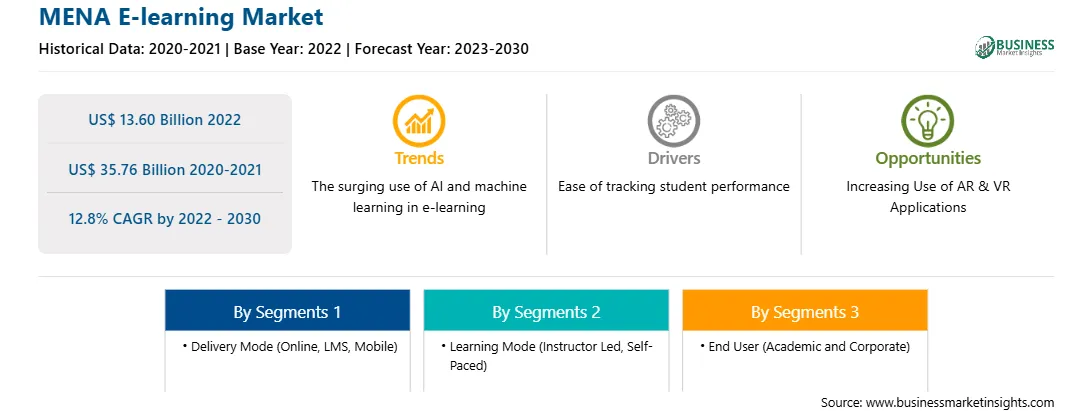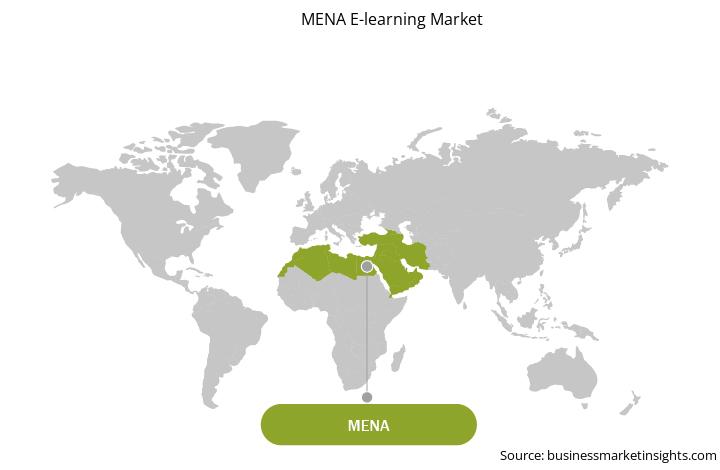The MENA E-learning market is segmented into Saudi Arabia, the UAE, Egypt, Jordan, Qatar, and the Rest of MENA. In the Middle East (ME), traditional academic institutions and newly founded online or hybrid educational organizations are still in the early stages of convincing students and their parents to embrace and adapt to the concept of e-learning. While a few traditional colleges have begun to offer a variety of e-learning courses, others are still in the early phases of establishing such programs. However, the increase in acceptance of e-learning solutions, stress on continuous learning practices by organizations, accountability mandates, and the use of cloud technology to speed up the learning process are a few major factors driving the e-learning market across the MENA region.
According to a study by Talent LMS, gamified E-learning courses tend to have a greater completion rate. In fact, gamified E-learning courses have a completion rate of 90%, while non-gamified courses have a completion rate of only 35%. Also, soft skills, IT skills, and business skills are the most popular among learners in the region. Communication skills, language, and project management skills follow this. The same survey found that the most preferred learning is through mobile devices, with 74% of learners preferring to access E-Learning content through their smartphones in the region.
The MENA e-learning market growth is attributed to the rising government expenditure in the education sector to increase the adoption of e-learning platforms. The Government of Saudi Arabia is encouraging e-learning programs to promote quality education. For instance, in February 2022, the Ministry of Education and the Saudi Electronic University inaugurated a forum on the future of learning and technology in Riyadh. The forum was established to adopt e-learning strategies and technologies in the education system across MENA countries. Additionally, according to the outgoing head of the education division at the African Union Commission, the co-managing director of the Arab States Research and Education Network (ASREN) announced to boost higher education outcomes and utilize educational and academic resources across Africa for a wider number of students. Also, various other institutions are undertaking initiatives to adopt e-learning portals, boosting the demand for e-learning solutions thus fueling the market growth. For instance, in May 2020, Microsoft partnered with C-Telecoms, Sahara Net, COMM-IT, Jawraa, Future Nas, and Al-Mayssan Technical Services to provide free half-day training on Teams to academic institutions in Saudi Arabia.
Based on delivery mode, the e-learning market is segmented into online, LMS, mobile, and others. The online segment held the largest share in the e-learning market in 2022. The popular and newest form of distance education today is online learning which is dominating the e-learning market. It has substantially impacted post-secondary education over the past decade, and the trend is increasing at a steady pace. Online learning allows learners to learn remotely, as most online educational tools are portable. Thus, the increasing reliance on online knowledge, coupled with technological advancements, is expected to increase the size of the online e-learning market as technology allows students to study entirely online while socializing by watching lectures with classmates and participating in subject-specific discussions. Online education enables teachers and students to set their own learning pace, and there is added flexibility to set a schedule that fits everyone. The use of an online educational platform, thus, allows for a better work and study balance.
Unlike in-person training methods, online education tends to be more affordable. Often, a wide array of payment options allows better budget management. With online education programs, one can save money by avoiding travel expenses to reach the institution and purchasing course materials. Therefore, the monetary investment, in other words, is less, but the results can be better than other options.
Based on learning mode, the e-learning market is segmented into instructor led and self-paced. The instructor led segment held the largest share in the e-learning market. E-learning provides the option of customizing the content according to the target group's desired learning style to keep trainees as a priority. Teacher-led learning is a learning process where one person (teacher) takes a lead role in the learning process by guiding the other learners. It can be carried out in a classroom setting or seminars. In addition, instructor-led training is traditionally used in the organization's method of training employees. The use of e-learning can make various aspects of instructor-led training simpler in organizations. It is relatively expensive to conduct instructor-led training sessions in physical workshops or classrooms, which limits the number of learners who can benefit from the process. Numerous corporate organizations follow the instructor-led training process to train their employees, whereby experienced employees usually take the role of an instructor. In contrast, comparatively less skilled employees take the role of learner.
Adobe Inc, Citrix Systems Inc, Coursera Inc, Oracle Corp, SAP SE, Udemy Inc, Little Thinking Minds CO LLCc, Synkers FZ-LLC, Lamsa FZ LLC, And Udacity Inc are among the key MENA E-learning Market players that are profiled in this e-learning market study.
The overall MENA E-learning Market size has been derived using both primary and secondary sources. Exhaustive secondary research has been conducted using internal and external sources to obtain qualitative and quantitative information related to the E-learning Market size. The process also helps obtain an overview and forecast of the market with respect to all the market segments. Also, multiple primary interviews have been conducted with industry participants to validate the data and gain analytical insights. This process includes industry experts such as VPs, business development managers, market intelligence managers, and national sales managers, along with external consultants such as valuation experts, research analysts, and key opinion leaders, specializing in the MENA E-learning Market.
Strategic insights for the MENA E-learning provides data-driven analysis of the industry landscape, including current trends, key players, and regional nuances. These insights offer actionable recommendations, enabling readers to differentiate themselves from competitors by identifying untapped segments or developing unique value propositions. Leveraging data analytics, these insights help industry players anticipate the market shifts, whether investors, manufacturers, or other stakeholders. A future-oriented perspective is essential, helping stakeholders anticipate market shifts and position themselves for long-term success in this dynamic region. Ultimately, effective strategic insights empower readers to make informed decisions that drive profitability and achieve their business objectives within the market.

| Report Attribute | Details |
|---|---|
| Market size in 2022 | US$ 13.60 Billion |
| Market Size by 2030 | US$ 35.76 Billion |
| CAGR (2022 - 2030) | 12.8% |
| Historical Data | 2020-2021 |
| Forecast period | 2023-2030 |
| Segments Covered |
By Delivery Mode
|
| Regions and Countries Covered | MENA
|
| Market leaders and key company profiles |
|
The geographic scope of the MENA E-learning refers to the specific areas in which a business operates and competes. Understanding local distinctions, such as diverse consumer preferences (e.g., demand for specific plug types or battery backup durations), varying economic conditions, and regulatory environments, is crucial for tailoring strategies to specific markets. Businesses can expand their reach by identifying underserved areas or adapting their offerings to meet local demands. A clear market focus allows for more effective resource allocation, targeted marketing campaigns, and better positioning against local competitors, ultimately driving growth in those targeted areas.

The MENA E-learning Market is valued at US$ 13.60 Billion in 2022, it is projected to reach US$ 35.76 Billion by 2030.
As per our report MENA E-learning Market, the market size is valued at US$ 13.60 Billion in 2022, projecting it to reach US$ 35.76 Billion by 2030. This translates to a CAGR of approximately 12.8% during the forecast period.
The MENA E-learning Market report typically cover these key segments-
The historic period, base year, and forecast period can vary slightly depending on the specific market research report. However, for the MENA E-learning Market report:
The MENA E-learning Market is populated by several key players, each contributing to its growth and innovation. Some of the major players include:
The MENA E-learning Market report is valuable for diverse stakeholders, including:
Essentially, anyone involved in or considering involvement in the MENA E-learning Market value chain can benefit from the information contained in a comprehensive market report.